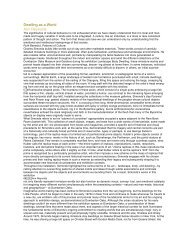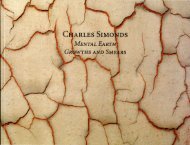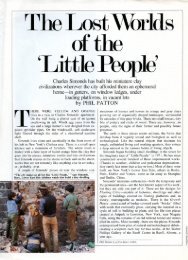Galerie Enrico Navarra
Dwellings - Charles Simonds
Dwellings - Charles Simonds
You also want an ePaper? Increase the reach of your titles
YUMPU automatically turns print PDFs into web optimized ePapers that Google loves.
•LandscapeBodyDwellin9", 1970Charles Simonds, 1 986conveys a quite different impression. It shows the artist'shead and hand, an image of extreme concentration followingupon one of Dionysian release, of painstaking laborfollowing upon a liberation from the earth. Simonds isbuilding one of his Dwellings out of eight-millimeter-longclay bricks, using a pair of tweezers. In the photograph,his head and hand seem gigantic. They are cropped toreveal a view of the tiny world over which the microsurgeoncarefully bends. The procedure shown here recallsthe assembly of computer chips in a lab more than theself-expression of an artist in his studio.And in fact, when we review Simonds' surviving worksor the photographs which are all that remains of them,his constructed world contains extremely complexground plans and a multiplicity of forms. Circular sites,pyramids, gates, tumuli, labyrinths are found, and noconfiguration repeats itself. And not only the shapes buttheir coloring passes through the finest nuances. Thisfeature would seem an essential part of the artist's message,for it alludes to the unique and unrepeatablenature of past events. (One thing should be noted in thiscontext: In the 1970s, when Simonds began to employarchitectural forms with a clearly archaeological, anachronisticcharacter, he did so in view of what was stillan unbroken belief in the modernity of the city. Today,these pieces strike us differently. Many of their configurationshave since been appropriated by postmodernistarchitecture, and have actually been built. Seen againstthe background of the postmodern canon, Simonds'architectural concetti take on a new, critical connotation.We interpret them as an evocation of the presentday in ruins.)The two photographs illustrate two contrary behaviorsspontaneityand calculation. Yet it is precisely an interplaybetween the two that determines Simonds' reuvre.As the exaggerated contrast between large and smallsuggests, the search for a door into his Dwellings willlikely never end. And even if the door could be found,what tool could Simonds ever use to break the lockbehind which his smaller-than-life dreamworld lies? Thesearch is destined to be futile. The only entry into thisimaginary realm can be through wish and desire. Seenin this light, Simonds' abandoned ghost cities havebeen abandoned by reason as well, and elude pragmaticuse. What they present is something inaccessible,something beyond the grasp of experience. The Go/emwho emerged from the clay is incapable of enteringthe Little People's world. He stands confronted by anillusion; he remains locked out.This aporia lends our involvement with Simonds' worka dramatic aspect. Simonds plays on our unconsciousanxieties and hopes. He plays those games of perspectivewhich remain with us from childhood onwards,the furniture of our subconscious mind. Everyone isfamiliar with them from the world of fairy-tales and legends,from stories like The Bottle-Imp, Swift's Gulliver'sTravels, or Grandville's "Les grands et les petits" in UnAutre Monde. The perceptual rupture that lends the toyworld its fascination or demonic attraction is also partof the furniture of science fiction movies. As examples,suffice it to name Ernest Shoedsack's Dr. Cyclops (1940),in which a mad scientist reduces his neighbors to dollsize, or Richard Fleisher's Fantastique Voyage (1966),17












